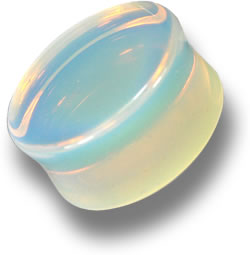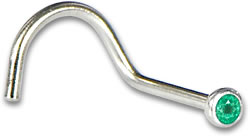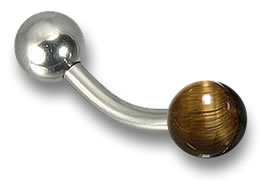|
Reviewed By Andreas Zabczyk
Guide to Buying Quality Body Jewelry Opal Gemstone Flesh Plug
A painful tradition described as modern primitivism has oozed its way into Western culture. Ancient practices once beyond the cultural norm have been developed and made trendy by recent generations. As the art of body modification and jewelry designs evolved, society and culture slowly learned to embrace and adapt to the unique and sometimes extreme decorative art and jewelry seen in today's Western urban subculture. As the demand for body modification jewelry increased, body jewelry became an art, with inspiration for designs coming from both the young and old. In the past, simple bars, rings and balls were mainly worn, but the need for personalized, unique designs increased. Nowadays, in today's specialized body jewelry shops, you can find just about anything from extravagant gemstone flesh plugs to customized coated barbells and threaded gemstone balls. Unlike most jewelry, such as rings or pendants, buyers need to be extremely careful when shopping for quality body jewelry. Since these special pieces of jewelry aren't simply being worn around your neck, but rather through your skin, its paramount to know what you're buying and wearing, because not all materials are considered safe to be worn under the skin for long periods of time. First off, it's important to note that there is no such thing as an industry standard when it comes to body jewelry like there is for gold, silver and diamond jewelry; nor are there any official regulations or government agencies in Europe, Asia or the USA that certify standards. So as the saying goes, 'buyers should beware'. Since, body jewelry is bought and sold in various outlets, ranging from high-end jewelry stores to anonymous online jewelry websites, and even sometimes convenience stores, how do buyers ensure they're not only getting a good deal, but also jewelry that is safe to be worn? To help distinguish true bargains from the sea of garbage, knowing some important facts about body jewelry is a good place to start.  Curved Apatite Nose Ring
Most of the body modification and piercing jewelry available today is made of stainless steel. However, many shoppers are unaware of the different grades of stainless steel available. You may often see stainless steel body jewelry described as 'surgical grade' steel, or even as 'hypoallergenic' steel, but don't be fooled by these terms, since there is no accepted definition when it comes to jewelry. Hypoallergenic jewelry is simply any form of jewelry made from pure metals such as gold, platinum or silver. But, since these are alloys, they can still cause allergic reactions. Surgical grade steel is only stainless steel suitable for the making of surgical equipment; it is designed to be easily cleaned and sterilized, but it is not designed to be implanted into the body for extended periods of time. When buying body jewelry, look for jewelry made of material compliant to ASTM standards. For stainless steel, this would be implant-grade 300 series steel, also known as 'austenitic steel'. If purchasing titanium body jewelry, purchase jewelry that is made with ASTM F136 or F67 grade titanium alloy. 'Industrial grade' or 'aircraft grade' titanium is not the same as human implant-grade titanium. Many sellers will describe their titanium as 'grade 23 titanium'; this is not implant-grade - this titanium is suitable for rings and jewelry worn on the outside of the body, but has not been proven or tested to be safe for extended periods of wear inside the body.  Tiger's Eye Curved Barbell Piercing
Coated and plated jewelry has become popular over recent years. The concept of plating and coating offers more vivid color options than the plain metallic look of traditional base metals. However, the downside is that coating and plating is not recommended, especially if your piercing is not fully healed. These types of coated body jewelry designs should be treated only as novelty and worn at your own risk. Most coated and plated jewelry is made with industrial grade materials and the outer layers may peal or chip away over time, which can lead to infections. The coatings may crack and break down as a result of your body's internal temperature and moisture, eventually leaking into the surrounding area, leading to severe discomfort. Some of the most common coatings used today include enamel, acrylic and PVD (Physical Vapor Deposition), usually layered over 'surgical grade' stainless steel and 'grade 23' titanium. Examples of plated body jewelry include forms of lower karat white gold or rhodium-plated metals. In most cases, gold alloys are safe to use for body jewelry but this depends on the purity. It is better to purchase 18 karat gold designs rather than 14 karat, since 14 karat will contain more impurities. Using or buying anything less than 14 karat gold for body jewelry is not recommended. Nickel is the most common allergy for jewelry-wearers, and most gold alloys contain nickel. In most countries, gold sellers are aware of the constituents in their alloys and can tell you whether or not the jewelry contains nickel. Even for those who do not suffer from nickel allergies, over time nickel can cause damage to nerves and blood vessels. The more nickel in your jewelry and the longer you wear it, the more damage can occur to the scar tissue and surrounding area. So if possible, ask for body jewelry that is nickel-free. So now that you have some basic knowledge in the world of modern primitivism and body modification jewelry, what are you waiting for? Go ahead and get pierced! Show off that fantastic natural turquoise gemstone flesh plug, and while you're at it, accessorize with a curved navel belly bar with a threaded citrine gemstone ball - just make sure to purchase quality materials made from natural gemstones and ASTM compliant, implant-grade metals only. There is always great value in jewelry made with quality craftsmanship and materials, but there is always a hidden cost when it comes to cheap jewelry made with inferior materials. This Page in Other Languages
|
| STAY IN TOUCH | NEWSLETTER |
| *You're signing up to receive GemSelect promotional email. |
Copyright © 2005-2024 GemSelect.com all rights reserved.
Reproduction (text or graphics) without the express written consent of GemSelect.com (SETT Company Ltd.) is strictly prohibited.
2571